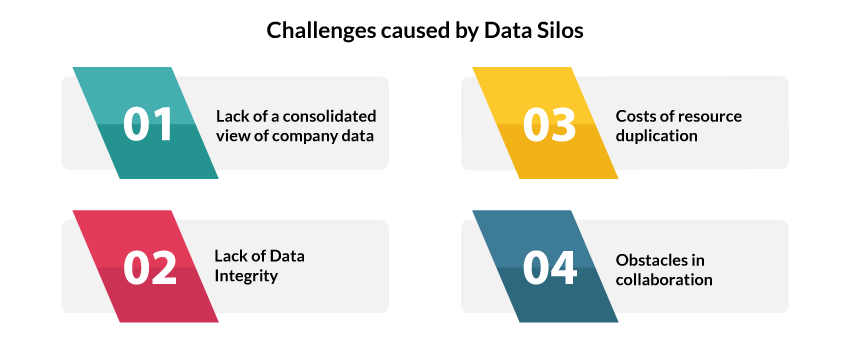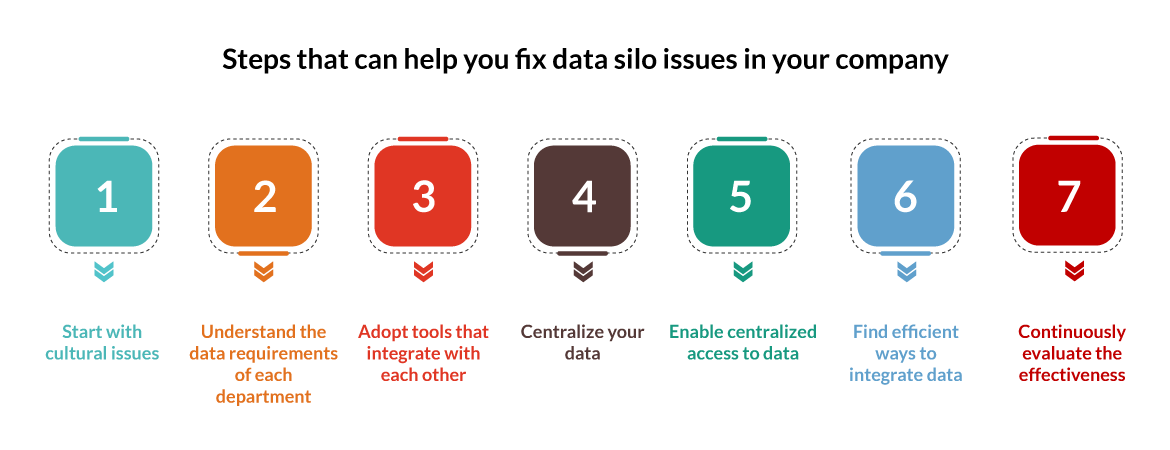
“You can have data without information, but you cannot have information without data.” – Daniel Keys Moran
“You can have data without information, but you cannot have information without data.”
daniel keys moran
Data is quickly becoming a currency today, and thus its importance only grows with time. Every business needs to find a smart way to manage its data and ensure that all its employees have access to the information they need. However, as every employee starts utilizing data, there are greater chances of creating Information silos, which can hinder productivity and reduce efficiency. With 82% of participants in this Forrester survey stating that managing data and sharing insights across business areas is challenging, data has never been more crucial to an organization’s success.
In this blog, we’ll discuss the basics of data silos and the different steps to help you overcome them in your organization.
What are Data Silos?
A data silo is a phenomenon in which there is a lack of coordination and cooperation when it comes to the sharing of information between different departments. This occurs when certain data is only accessible by a specific group of people and not shared with other groups and departments.
If two systems or departments need to work together, but the data is not being shared equally between the two parties, this essentially creates two separate data silos on behalf of the two parties. This can lead to various issues that can cause additional costs and time loss for the business or company in question.
There can also be 3 different types of silos, each of which stems from different issues. Cultural issues can cause silos to form due to high competitiveness or inter-departmental politics, which hinder the teams and departments from working together. Structural issues can cause silos due to many layers of hierarchy in the management and highly specialized teams that cannot work together efficiently. Technological issues can lead to silos as certain applications may not be available for use by certain departments or may not integrate with existing systems properly, leading to data silos.
How do silos get formed?
Data silos are created due to structural, cultural, or technological issues that can prevent information from being freely shared. Sometimes it’s due to complacency on behalf of the company, as they are no longer observant, which leads to a lack of shared information throughout the organization. Cultural issues within the company can also play a big role in silos forming due to inter-office politics, interdepartmental politics, and team cliques. This can lead to an unfriendly work environment with information hoarding, decreasing productivity and efficiency.
However, silos aren’t always bad news. Silos can also be formed when a certain department in a company isn’t intentionally sharing its information with the rest of the company. If every department unconditionally shared all of its information, it could lead to an overwhelming amount of unnecessary information. This information overload could cause problems moving forward, so it’s important to catch data silos and rectify them according to problems that need to be solved in workflows and end results.
For example, if your manufacturing department doesn’t need all of the information from your marketing department, a data silo being formed in the marketing department can be a good thing. However, if your marketing and sales departments need to work together on a project and key information isn’t being given, this can be a problematic silo that could cause lowered productivity and efficiency. This silo may be caught easily and solved if the proper protocols and workflows are in place.
Silos can be created easily, so they’re so difficult to remove. An employee using multiple files to record the same information creates a data silo. A vendor platform that lacks integration features is creating a data silo. A department that is collecting unstandardized information is creating a data silo. These examples are so commonplace that it might be difficult for organizations to find these silos and take care of them. However, not every silo is problematic, and every situation is unique.
Watch Webinar: Experience Data Transformation with Quixy’s Modern Data Source
Each department in an organization has different requirements and needs. This translates into a requirement for different COTS applications and tools for every use case throughout each department. Procuring these tools is one issue, but another bigger issue is ensuring that these tools integrate with each other seamlessly. If they cannot integrate and share data smoothly, this can cause data silos which can cause many more problems down the road.
Silos need to be handled carefully as there can be unique advantages and disadvantages to every single one. Also, silos cannot be created without a team or department in charge of the data. Data silos can help you pinpoint the organizational silos created within the staff, which might lead to further problems in the future, and help set proper procedures with these teams from the get-go. Standardizing your information-sharing procedures can definitely prevent silos from forming in the first place.

What are the Challenges caused by Data Silos?
As times have changed, data has quickly become key to the success of any company.
This means that it is extremely important to manage your data efficiently to get the best results, and if it isn’t done adequately, problems with inefficient scaling, decreasing business intelligence, and lessened coordination of departments on projects can occur. Data silos can also lead to the following challenges for your company:

1. Lack of a consolidated view of company data
When data silos occur, they can prevent you from getting a holistic view of your company’s data. Either the data, on the whole, will be incomplete, or you will only be able to observe and analyze a fragmented part of your overall data. This can prevent you from conducting a proper analysis, leading to missing out on key insights. Also, keeping your data in a simplistic format can prevent you from getting deeper and better insights through programs that filter through lots of raw data. Silos can also be identified quickly if your data is fed into analytics software.
2. Lack of Data Integrity
Data fragmentation is commonplace wherever data silos are formed, which can lead to a lack of data integrity. The data in silos may never be updated or reviewed, leading to inaccurate and stale data. This inaccurate data may cause further issues involving productivity and costs if used by employees or in any analysis. Thus, data silos can lead to numerous issues in the future if they aren’t dealt with promptly.
3. Costs of resource duplication
Due to duplicate resources, data silos can cause additional costs related to storing, moving, collecting, and using data. If data is supplicated, poorly maintained, or redundant, these can just become further costs.
4. Obstacles in collaboration
Data silos may emerge due to organizational silos, pointing to a larger problem among the staff at your company. If there are cultural issues between teams and departments, these issues will get amassed until it becomes impossible for the two departments to ever work together on a project. This will also lead to technological incompatibilities, which can become a further obstacle in information sharing. There is specialized software in the market to solve the issues of technical data silos and consultants to provide custom solutions, so these silos can be dealt with quickly. However, addressing organizational problems in collaboration between the two departments will become essential to the smooth functioning of a company.
Also Read: Mastering Multiple Series Reports: Visualizing Complex Data in 4 Steps
What is the difference between Data Silos vs Data Lakes?
Data silos are avoidable, especially if your data is consolidated in a centralized place. You can make it easier for your employees to access information and data if it’s all located in one place. A data lake is one such repository of data.
A data lake is a centralized repository that stores all of the information on a single interface. Data lakes can prevent data silos from piling up and ensure your data is ready for analysis. This form of data collection can also work well with big data analytics, which can help you gain valuable, actionable insights from your raw data. Data lakes are a relatively new form of data management that can take your data management to the next level.
Data lakes have multiple benefits, including better data security, better workflows, a better path to scalability, increase chances of finding valuable insights, and faster comprehension of new data. Changing lead times and minimizing IT costs on the whole. Furthering business growth and taking advantage of the data can be done easily by businesses if they use data lakes as their preferred data management system.
A data lake is a centralized repository that stores all of the information on a single interface.
How can you Prevent Data Silos from Causing Problems in your Company?
As mentioned above, fixing any data silo problem starts with tackling any organizational silos and problems within your staff and departments. A data silo is generally an indicator of an organizational silo, and dealing with that can help you solve the problem at its root. After tackling the organizational silo, you can take care of the technical silos using a solution available on the market or on your own. Here are a few steps that can help you fix data silo issues in your company:

1. Start with cultural issues
Data silos are often formed due to cultural and organizational issues, so you must start fixing this. The benefits of data sharing need to be clearly communicated to prevent future problems. As long as the organization’s members understand these benefits, there will be an increase in productivity and efficiency. Data literacy, sore points in teamwork and the work culture, and conflicting goals need to be identified and solved to ensure that everyone in the company is working towards a unified data platforms in general and when it comes to data collection and management.
2. Understand the data requirements of each department
You need to continuously check in with departments regarding what data they need. This will ensure that the right departments have access to the right data, which can lead to better efficiency and productivity. This can help avoid data silos and avoid them in the future continuously.
3. Adopt tools that integrate with each other
Making sure you adopt tools that integrate seamlessly with each other is key to avoiding data silos. This is a good method for ensuring that your tools don’t unnecessarily create silos and instead share information easily.
Also read: 10 Essential Features of a BPM Platform that you definitely need!
4. Centralize your data
Find a way to centralize your data to prevent data silos from occurring. Consolidated and standardized data in a central repository will help your employees retrieve their data without any obstacles or setbacks. One of the best methods of dealing with data silos is to centralize the data on a cloud-based system like data lakes.
5. Enable centralized access to data
Having a central data repository can lead to easily centralizing data governance. This can lead to granting permissions easily for concerned company members when they need specific data. This can also help you record which data is required by departments throughout the company.
Also Read: Break Down Data Silos: The Power of Enterprise Application Integration
6. Find efficient ways to integrate data
Different methods exist to integrate your data silos into your centralized data systems. Integrating these silos is essential for creating a consolidated repository and methods such as automation and cloud-based automation can help simplify the business process. ETL (Extract, Transform, Load) Tools can help you transfer your siloed data into your repository easily and there are 2 different variants: cloud-based and on-premises. These technologies can help you integrate your data quickly and efficiently. This can also help prime data to be analyzed and help you gain key insights easily.
7. Continuously evaluate the effectiveness
You need to constantly keep an eye on whether the current data management and collection processes are standardized and well-managed. This can ensure you don’t run into any data silos and other problems in the future and keep all your data consolidated. Constant vigilance will ensure that you don’t encounter any future issues that might spring up with organizational silos.
Also Read: 10 Step Ultimate Guide to Business Process Management (BPM) Implementation
Summary
Data silos are practically unavoidable, especially as your business grows and scales. Managing your data and taking advantage of it to unearth valuable insights grows more important day by day. In a competitive market, your data and customers are the most important things to stay relevant, and managing your data successfully can give you an edge over your competitors. To prevent data silos from hindering your progress, it’s important for you to tackle this problem at a cultural level.
Quixy is a no-code, low-code platform that can help you increase productivity and accelerate your business. This platform can enable you to automate processes from various departments such as CRM, Helpdesk, Expenses Management, etc. Since your processes can be present on one platform and tool, you won’t need to look for different COTS tools for each of these departments, leading to a reduction of data silos across the organization.
With an intuitive visual designer and a drag-and-drop builder, Quixy can help you make the platform that your business needs, without writing a single line of code. Don’t miss out on the chance to elevate your processes. Take the first step and get started with Quixy today.
Frequently Asked Question(FAQs)
What is an Example of a Data Silo?
Think of a data silo like a separate storage room for data. An example could be your sales team keeping their customer info in one system, while the marketing team has it in another. They’re not sharing the same data space.
Is Data Silo a Problem?
Yes, it can be a big problem. Data silos make it hard for different parts of a business to collaborate and make decisions based on the full picture. It can lead to inefficiency and missed opportunities.
Difference Between Data Warehouse and Data Silo?
A data warehouse is like a central library where all your data is organized and accessible to everyone. A data silo is when data is stuck in separate places, making it hard to find and use.
Why Do Data Silos Happen?
Data silos often happen because different teams or systems use their own databases or tools. Sometimes it’s due to historical reasons or a lack of communication between departments.
Data Silo vs. Data Mart?
A data silo is like a storage room with isolated data. A data mart is a smaller, specialized version of a data warehouse, focused on a specific area or department. Marts are more organized than silos but still not as comprehensive as a warehouse.
Subscribe
Login
Please login to comment
0 Comments
Oldest
















